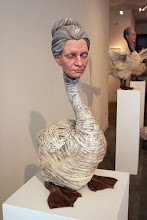Ladies and gentleman, it is my pleasure to present to you a lovely little video of Eric LoPresti working in his Brooklyn studio and preparing for his Spring show at Like the Spice which opens on April 8th. Eric was nice enough to share the video with me so that I might, in turn, share it with all of you! Now, for me personally it's hard not to think about process and technique when it comes to the production of art (surprise!), but that is most likely because it is my business to know all about respective processes and techniques; however, I do know that for many the enjoyment of a piece is mostly inspired by the end result, the finished product. This of course is all fine, more than fine really, if you like something you should like it, love it even, just for what it is. I promise not to call on any of you and put you on the spot asking you what your favorite piece of art is and then follow up with the dreaded query, 'why'? Whether process and technique are your bread and butter (I myself have the Scientific Method tattooed on my inner arm, *ahem*), or you are more focused on the end result and enjoying the polished product post production, I am certain that the following video of Eric LoPresti preparing a canvas by working on the underpainting for a new piece, along with it's explanation will be interesting to you (and don't tell me you don't have time, the video is only 1:30)...Enjoy!

In the video, Eric lays down the color gradient first, then the landscape is painted on top, almost floated on the surface, and then lastly the black lines are added. This way of working is almost a backwards way to do grisaille (pronounced griz-ai), the traditional practice of using a monochromatic or burnt umber toned outline as the under-layer and then glazing color over it. A grisaille may be executed for its own sake, but is most often used as underpainting for an oil painting.
Eric's reason for laying down color first is to use the color gradients as an optical effect, "like seeing through a rainbow or the chromatic distortion of a camera lens." For him, color sets the tone of each piece. And, since he takes color quite seriously, Eric rarely uses his oil paint straight out of the tube, instead pre-mixing his colors on a paper palette (seen laid out at left in the video). With the paint mixed he then brushes the gradient onto the canvas in broad, light, loose strokes. His left hand holds a digital sketch outlining roughly where we would like the colors to go, in many thin layers of paint.
See, now wasn't that cool? Even I learned a few things (example: those blue gloves protect Eric's hands from turpentine and other chemicals used to thin out oil paints, and are NOT a fashion statement). Keep your eyes out for more news on Eric's show and more studio peaks to come!
